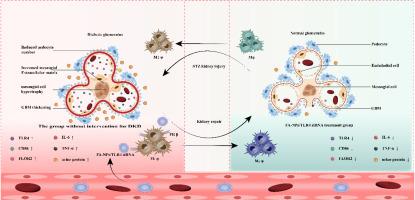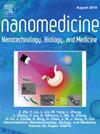A novel treatment for diabetic nephropathy: Folate receptor-targeted delivery of TLR4 siRNA via functionalized PLGA nanoparticles in streptozotocin-induced diabetic murine models
IF 4.6
2区 医学
Q2 MEDICINE, RESEARCH & EXPERIMENTAL
Nanomedicine : nanotechnology, biology, and medicine
Pub Date : 2025-09-05
DOI:10.1016/j.nano.2025.102856
引用次数: 0
Abstract
Diabetic kidney disease (DKD), a prominent microvascular complication of diabetes mellitus and the leading cause of end-stage renal disease (ESRD), was addressed through a novel nanotherapeutic approach. This study engineered folic acid-conjugated poly(lactic-co-glycolic acid) nanoparticles (FA-PLGA NPs) for the folate receptor (FR)-targeted delivery of Toll-like receptor 4 small interfering RNA (TLR4 siRNA) to treat diabetic nephropathy (DN). In a streptozotocin-induced DN murine model, administration of FA-PLGA NPs/TLR4 siRNA significantly mitigated renal injury compared to untreated DN controls. This was evidenced by reduced mesangial matrix expansion, downregulation of TLR4/CD86/FLOR2 expression, decreased urinary protein excretion, and lowered circulating IL-6 and TNF-α levels. Importantly, renal function parameters, including urea nitrogen, serum creatinine, and albumin) were restored to near-normal levels. These results demonstrate that FRβ-targeted TLR4 siRNA delivery via FA-PLGA NPs effectively reduces inflammation and renal damage, establishing a promising novel therapeutic strategy for DN.

一种治疗糖尿病肾病的新方法:在链脲佐菌素诱导的糖尿病小鼠模型中,叶酸受体靶向TLR4 siRNA通过功能化PLGA纳米颗粒传递。
糖尿病肾病(DKD)是糖尿病的主要微血管并发症,也是终末期肾脏疾病(ESRD)的主要原因,通过一种新的纳米治疗方法得到了解决。本研究设计叶酸偶联聚(乳酸-羟基乙酸)纳米颗粒(FA-PLGA NPs)用于叶酸受体(FR)靶向递送toll样受体4小干扰RNA (TLR4 siRNA)治疗糖尿病肾病(DN)。在链脲佐菌素诱导的DN小鼠模型中,与未治疗的DN对照组相比,给予FA-PLGA NPs/TLR4 siRNA可显著减轻肾损伤。这可以通过肾小球系膜基质扩张减少、TLR4/CD86/FLOR2表达下调、尿蛋白排泄减少、循环IL-6和TNF-α水平降低来证明。重要的是,肾功能参数,包括尿素氮,血清肌酐和白蛋白)恢复到接近正常水平。这些结果表明,fr β靶向TLR4 siRNA通过FA-PLGA NPs传递可有效减少炎症和肾脏损害,为DN建立了一种有前景的新治疗策略。
本文章由计算机程序翻译,如有差异,请以英文原文为准。
求助全文
约1分钟内获得全文
求助全文
来源期刊
CiteScore
11.10
自引率
0.00%
发文量
133
审稿时长
42 days
期刊介绍:
The mission of Nanomedicine: Nanotechnology, Biology, and Medicine (Nanomedicine: NBM) is to promote the emerging interdisciplinary field of nanomedicine.
Nanomedicine: NBM is an international, peer-reviewed journal presenting novel, significant, and interdisciplinary theoretical and experimental results related to nanoscience and nanotechnology in the life and health sciences. Content includes basic, translational, and clinical research addressing diagnosis, treatment, monitoring, prediction, and prevention of diseases.

 求助内容:
求助内容: 应助结果提醒方式:
应助结果提醒方式:


